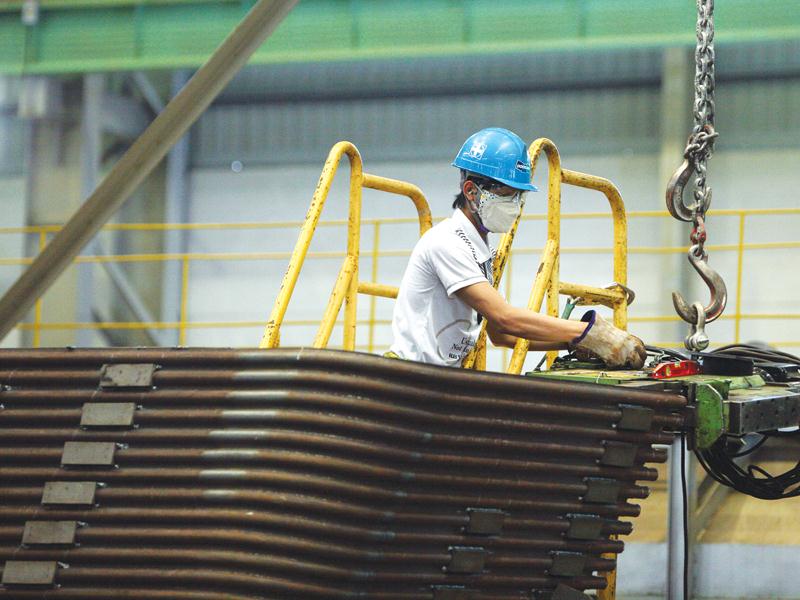Economists warn of growing trade deficit towards South Korea
 |
| Vietnam’s main imports from South Korea serve the purposes of manufacturing, processing products for exporting. Photo: manufacturing at Doosan Vina |
| RELATED CONTENTS: | |
| Trade deficit increases day by day | |
| Overview: 25 years of Korean investment | |
| A glimpse into the future of Korean-Vietnamese ties | |
Slipping deeper into the red
According to statistics recently released by the Ministry of Planning and Investment, in the first four months of this year, Vietnam’s trade deficit towards China totalled at $9 billion, while it was $9.3 billion towards Korea.
Hence, South Korea is the new champion trading partner of Vietnam, taking over China, despite the fact that the largest portion of Vietnamese imports is still sourced from the latter. Specifically, in the first four months of the year, Vietnam imported $17.6 billion worth of products from China, an increase of 19.4 per cent, while the import turnover from South Korea was $13.7 billion, up 45.3 per cent in comparison with the same period last year.
In fact, warnings about Vietnam’s growing trade deficit towards South Korea have been souding for about a dozen years now, probably since Samsung started investing a large amount in manufacturing complexes in Vietnam. In 2008, Vietnam’s trade deficit with South Korea was $6.27 billion. This figure increased to $8.46 billion in 2011, to reach $20.6 billion in 2016. In the first four months of this year, Vietnam’s trade deficit towards South Korea reached $9.3 billion, not breaking the monotonously increasing trend.
For years, the public opinion seemed to be sharply focused on China instead of South Korea. However, since South Korea unexpectedly surpasses China in trade deficit, economists have been warning to exercise caution.
It is not too difficult to explain why the trade deficit to South Korea has been soaring. After Samsung started making large investments in manufacturing complexes in the country, the wave of investment from South Korea has been increasing strongly. As of April 2017, South Korean accumulative investment capital was over $54 billion, topping off the list of countries and territories investing in Vietnam, going far beyond rank two Japan’s $10 billion. South Korean enterprises have been investing heavily in Vietnam, bringing about a demand to import machinery, equipment, and materials.
Vietnam Export-Import Report 2016, published by the Ministry of Industry and Trade, also mentioned this issue. According to Deputy Minister of Industry and Trade Tran Quoc Khanh, Vietnam’s main imports from South Korea serve the purposes of manufacturing, processing, and exporting products. Only in 2016, the total import turnover from South Korea was $32 billion, up 15.9 per cent on-year. Many trade items saw increases at a similar pace.
| Trade items | Y-O-Y increase (against 2015) | 2016 Import Turnover |
| Computers, electronic products and components | 28.8 per cent | $8.7 billion |
| Machinery, equipment and spare parts | 14.1 per cent | $5.8 billion |
| Phones and components | 18.4 per cent | $3.6 billion |
| Fabrics | 5.5 per cent | $2 billion |
Looking for solutions
The large trade deficit towards South Korea is not an overly large concern because Vietnam’s main imports focus on materials and equipment serving production, business, and investment. However, an over-large trade deficit may have unhealthy implications.
During the meeting with the Minister of Foreign Affairs of the Republic of Korea Yun Byung-se in March 2017, Pham Binh Minh, Deputy Prime Minister and Minister of Foreign Affairs, suggested that the South Korean government take effective measures to gradually balance trade and reduce Vietnam’s trade deficit, as well as facilitate the import of Vietnamese agricultural, forestry, and fishery products into South Korea.
The two-way trade between Vietnam and South Korea grew dramatically since large South Korean corporations have been flocking to invest in Vietnam, especially after the Vietnam-Korea Free Trade Agreement (VKFTA) came into effect. However, the growth rate of South Korean imports from Vietnam failed to meet expectations, as many Vietnamese export products have yet to properly penetrate the South Korean market.
For example, among the countries entering into free trade agreements with South Korea, Vietnam is the first partner that can access the market for highly sensitive products, such as garlic, ginger, honey, and sweet potatoes. However, it is difficult to export these items massively because the Sanitary and Phytosanitary Measures (SPS Agreement) adopted by South Korea and applicable to fresh fruits, are impeding Vietnamese goods.
Removing the difficulties related to the SPS is essential for Vietnam to boost exports to South Korea. However, according to economists, in order to reduce the trade deficit towards South Korea, it is important that Vietnam restructure the economy and develop supporting industries. If the dependency on imported materials persists, the trade balance between Vietnam and South Korea will grow to significant proportions.
What the stars mean:
★ Poor ★ ★ Promising ★★★ Good ★★★★ Very good ★★★★★ Exceptional
Latest News
More News
- Government moves to establish International Financial Centre (December 21, 2025 | 21:00)
- Vietnam's IFC to target global investment flows (December 21, 2025 | 18:00)
- Ha Tinh breaks ground on major Vingroup industrial and energy projects (December 19, 2025 | 18:24)
- EVN launches major power infrastructure projects nationwide (December 19, 2025 | 18:17)
- VAL inaugurates second production line to meet domestic animal feed demand (December 19, 2025 | 16:37)
- Sun Group pioneers urban tram system in Phu Quoc (December 19, 2025 | 15:00)
- Top 10 notable events of Vietnam’s industry and trade sector in 2025 (December 19, 2025 | 14:00)
- Seven major projects launched to drive Hanoi’s next growth phase (December 19, 2025 | 14:00)
- Rare, beautiful, sustainable: the mark of iconic real estate (December 19, 2025 | 08:00)
- Mondelez Kinh Do - a chapter of purpose-led leadership in Vietnam (December 18, 2025 | 09:44)
















 Mobile Version
Mobile Version